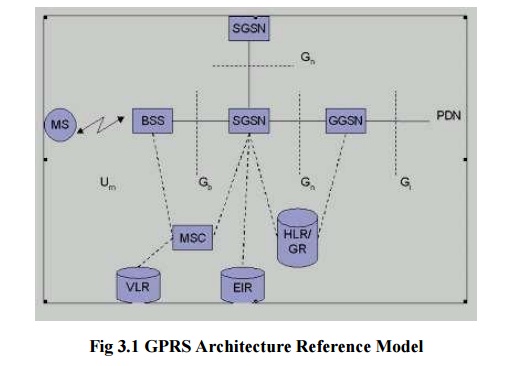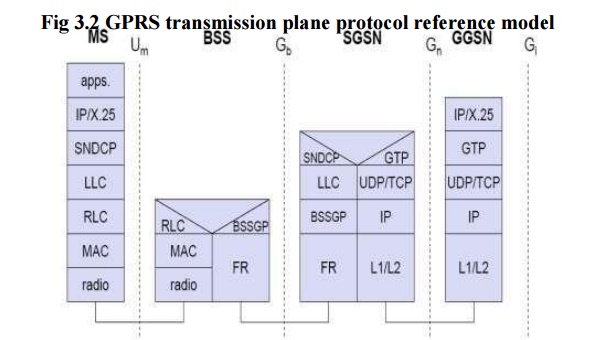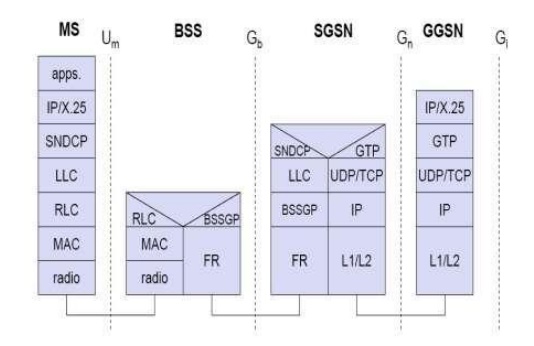Chapter: Mobile Networks : Cellular Wireless Network
GPRS
GPRS
INTRODUCTION:
General packet radio service (GPRS) is
a packet oriented mobile data service
available to users of the 2G cellular communication systems, 3G systems and
GSM. GPRS re-use the existing GSM infrastructure. It interworked with existing
circuit-switched services. It is based on standardized open interfaces.
GPRS
usage is typically charged based on volume of data transferred, contrasting
with circuit switched data, which is usually billed per minute of connection
time. 5 GB per month for a fixed fee or on a pay-as-you-use basis. Usage above
the bundle cap is either charged per megabyte or disallowed.
GPRS is a
best effort service, implying variable throughput and latency that depend on
the number of other users sharing the service concurrently, as opposed to circuit
switching, where a certain quality of service (QoS) is guaranteed during
the connection. In 2G systems, GPRS provides data rates of 56–114 kbit/second.
2G cellular technology combined with GPRS is sometimes described as 2.5G, that is, a technology between the
second (2G) and third (3G) generations of mobile telephony. It provides
moderate-speed data transfer, by using unused time division multiple access
(TDMA) channels in, for example, the GSM system. GPRS is integrated into GSM
Release 97 and newer releases.
GPRS
provides two services:
1. Point-to-point
(PTP)
2. Point-to-multipoint
(PTM)
In
point-to-point packet delivery service, in which packet is transfer between two
users and in point-to-multipoint (PTM)
service, in which packet is delivering to multiple destinations within one
service request.
In PTP
versions are PTP Connection oriented Network service (PTP-CONS), which establish a logical relation in between users.
Multiple packets are sent between
single source and a single destination. Other version is the PTP Connectionless
Network Service (PTP-CLNS), which
does not require a logical link between users. Packets are sent between a
single source and a single destination. Each packet is independent of its
predecessor and successor.
QoS-profile can be
specified by the users of the GPRS. It is maintained in the PDP context. PDP Context
is nothing but which is created in each communication session. QoS-profile is
used to indicate the network and radio resources required for data
transmission. It has the attributes such as service precedence
(high,normal,low),reliability class, delay class, peak throughput class, mean
throughput class. GPRS must allocate radio resources to fulfill these user specifications.
GPRS network is suffered by the following delays such as channel access delay,
coding for error correction and transfer delay in the fixed part and wireless
part of the network. GPRS also includes several security services namely
authentication, user identity confidentiality, access control and user
information confidentiality.
Main benefits
Resources
are reserved only when needed and charged accordingly. Connection setup times
are reduced. It will enable new service opportunities. It has High Speed (Data
Rate 14.4 – 115 kbps). It uses the efficient radio bandwidth (Statistical
Multiplexing).Circuit switching & Packet Switching can be used in parallel.
It has Constant connectivity.
Characteristics of GPRS:
1. GPRS uses
packet switched resource allocation.
2. Flexible
channel allocation.
3. Support
for leading internet communication protocols.
GPRS Terminal Classes:
1. Class A
It can be
connected to GPRS service and GSM service (voice, SMS), using both at the same
time. Such devices are known to be available today.
2. Class B
It can be
connected to GPRS service and GSM service (voice, SMS), but using only one or
the other at a given time. During GSM service (voice call or SMS), GPRS service
is suspended, and then resumed automatically after the GSM service (voice call
or SMS) has concluded. Most GPRS mobile devices are Class B.
3. Class C
They are
connected to either GPRS service or GSM service (voice, SMS). Must be switched
manually between one or the other service.
GPRS ARCHITECTURE
In order
to understand the GPRS network architecture, some fundamental GSM terminology
is necessary. This section describes some of the main components of the GSM
network.
GPRS Networks
GPRS architecture
has two network elements, which are called as GPRS support nodes (GSN).They are,
1. Gateway
GPRS Support Node(GGSN)
2. Serving
GPRS Support Node (SGSN)
All GSNs
are integrated into the standard GSM architecture and many interfaces (see
figure 1). The network elements are gateway
GPRS support node (GGSN) is provisioned by router, which supports
traditional gateway functionality. It is the interworking unit between the GPRS
network and external packet data
networks (PDN). This node
contains routing information for GPRS users. It performs address conversion and tunnels data to a user via encapsulation.

The other element is the serving GPRS support node (SGSN) which connects BSS and GGSN. It supports the MS via the Gb interface. It requests the user address from the GPRS register (GR). It keeps track of the individual MSs‘ location, is in charge for collecting billing information. It performs many security functions.
Packet Control Unit (PCU)
The PCU
separates the circuit switched and packet switched traffic from the user and
sends them to the GSM and GPRS networks respectively. It also performs most of
the radio resource management functions of the GPRS network. The PCU can be
either located in the BTS, BSC, or some other point between the MS and the MSC.
There will be at least one PCU that serves a cell in which GPRS services will
be available. Frame Relay technology is being used at present to interconnect
the PCU to the GPRS core.
GPRS interfaces
Um between
an MS and the GPRS fixed network part. The Um is the access interface the MS uses to access the GPRS network. The radio
interface to the BTS is the same interface used by the existing GSM network
with some GPRS specific changes.
Gb between a
SGSN and a BSS. The Gb interface carries the GPRS traffic and signaling between the GSM radio
network (BSS) and the GPRS network. Frame Relay based network services is used
for this interface.
Gn between
two GSNs within the same PLMN. The Gn provides a data and signalling interface in the Intra -PLMN backbone. The GPRS
Tunnelling Protocol (GTP) is used in the Gn (and in the Gp) interface over the
IP based backbone network.
Mobile Station
A GSM
subscriber needs a terminal called Mobile
Station (MS). It is used to
connect
to the network using the radio interface Um. In idle mode an MS is
not reachable and all contexts will be deleted. In the standby state there is
only movement across routing areas which is updated to the SGSN. Before sending
any data over the GPRS network, an MS must attach to it, following the
procedures of the mobility management.
The attachment procedure includes assigning a temporal identifier, called a temporary logical link identity (TLLI),
and a ciphering key sequence number
(CKSN) for data encryption.
GPRS BSS
Base Station Subsystem (BSS) which
performs radio-related functions. BSS contains
Base Transceiver Stations (BTS) and Base Station Controllers (BSC).
BTS which provides new GPRS channel
coding schemes through Channel Codec
Unit (CCU). The BTS handles the radio interface to the MS. It consists of radio
equipment (transceivers and antennas) required to service each cell in the
network.
BSC forwards
the Circuit-switched calls to MSC and the Packet-switched data to SGSN. The BSC provides the control functions and physical
links between the MSC and the BTS. A number of BSCs are served by one MSC while
several BTSs can be controlled by one BSC.
The Network Switching Subsystem
The NSS
is responsible for call control, service control and subscriber mobility manage
a) Mobile Switching center (MSC)
MSC is in
charge for telephony switching functions of the network. It also performs
authentication to verify the user‘s identity. It ensures the confidentiality of
the calls. The Authentication Center (AuC) provides the necessary parameters to
the MSC to perform the authentication procedure. The AuC is shown as a separate
logical entity but is generally integrated with the HLR. The Equipment Identity
Register (EIR) is on the other hand a database that contains information about
the identity of the mobile equipment. It prevents calls from unauthorized or
stolen MSs.
b)Home Location register (HLR)
HLR is a
database used to store and manage permanent data of subscribers. HLR is used to
map an MS to one or more GGSNs. It is used to update the SGSN of the MS. It is
also used to store the fixed IP address and QoS profile for a transmission
path.
c) Visitor location register
(VLR)
VLR is a
database used to store temporary information about the subscribers. It is
needed by the MSC in order to service visiting subscribers. The MSC and VLR are
commonly integrated into one single physical node and the term MSC/VLR is used
instead. When a subscriber enters a new MSC area, a copy of all the ne) cessary
information is downloaded from the HLR into the VLR. The VLR keeps this
information so that calls of the subscriber can be processed without having to
interrogate the HLR (which can be in another PLMN) each time. The temporary
information is cleared when the mobile station roams out of the service area.
d)Equipment identity register (EIR)
EIR is
also a database that encloses information about the identity of the mobile
equipment. It prevents calls from unauthorized or stolen MSs.
GPRS Mobility Management States
a)Idle State
A MS in
the idle state is not traceable and can only receive PTM-M transmissions such
as general broadcast events destined to a specific geographical area. The MS
needs to perform the attach procedure in order to connect to the GPRS network
and become reachable.
b)Ready State
Data is
sent or received in this state. The MS informs the SGSN when it changes cells.
The MS may explicitly request (or can be forced by the network) to detach in
which case it moves to Idle. A timer monitors the Ready state and upon its
expiry, the MS is put on Standby. The timer insures that resources are not
wasted by an inactive MS.
c)Standby State
A
connected MS which is inactive is put in the Standby state. Moving back to
Ready can be triggered by sending data or signalling information from the MS to
the SGSN. Upon arrival of data destined to the MS, the SGSN pages the latter
and a response to the page moves the MS back to the Ready state. The MS may
wish (or can be forced by the network) to terminate the connection by
requesting to detach in which case it returns to Idle. A timer is used by the
SGSN to monitor the tracking of the MS, and when it expires, the MS is detached
and is considered unreachable
GPRS PROTOCOL ARCHITECTURE
A GPRS
network introduces many new protocols designed to convey user data in a
reliable and secure way. The protocol architecture is implemented for the
transmission and signaling planes in GPRS. Transmission
plane protocols are used for the
transmission of user data and control functions. Signaling plane protocols are used to convey signaling information
that controls and supports the transmission
plane functions. (See figure 2).


Transmission protocols in the Um interface
a) Physical layer
The
physical layer can be divided into the Radio Frequency (RF) layer and the
Physical Link layer.
The Radio Frequency (RF) is the normal GSM
physical radio layer. Among other things the RF layer specifies the carrier
frequency characteristics and GSM radio channel structures. It uses the radio
modulation scheme for the data. The GSM RF physical layer is used for GPRS with
the possibility for future modifications.
The Physical Link layer supports multiple
MSs sharing a single physical channel and provides communication between the
MSs and the network. Network controlled handovers are not used in the GPRS
service. Instead, routing area updates and cell updates are used.
b)Medium Access Control (MAC)
MAC
protocol handles the channel allocation and the multiplexing. The RLC and the
MAC together form the OSI Layer 2 protocol for the Um interface. The
radio
interface at Um need GPRS which does not require changes compared to
GSM.
c) Radio Link Control (RLC)
RLC
protocol establishes a reliable radio link to the upper layers. It also works
either in acknowledged or unacknowledged modes.
Logical Link Control (LLC)
LLC layer
establishes a secure and reliable logical link between the MS and the SGSN for
upper layer protocols. It works either in acknowledged or unacknowledged modes.
The data confidentiality is ensured by using ciphering functions.
Subnetwork dependent convergence protocol (SNDCP)
SNDCP is
used to transfer data packets between SGSN and MS. It is used to provide
multiplexing of several connections of network layer onto one logical
connection of underlying LLC layer. It provides functions that help to improve
channel efficiency. This is achieved by means of compression techniques. Data
Link layer is divided into LLC layer and RLC/MAC Layer.
Transmission protocols in the Gb interface
a)Physical Layer Protocol
Several
physical layer configurations and protocols are possible at the Gb interface
and the physical resources are allocated by Operation & Maintenance
(O&M) procedures. Normally a G703/704 2Mbit/s connection is provided.
b) Network Services layer
The Gb
interface Network Services layer is based on Frame Relay. Frame Relay virtual
circuits are established between the SGSN and BSS. LLC PDUs from many users are
statistically multiplexed onto these virtual circuits. These virtual circuits
may traverse a network of Frame Relay switching nodes, or may just be provided
on a point to point link between the BSC and the SGSN.
Base station subsystem GPRS
protocol (BSSGP)
BSSGP is
used to deliver routing and QoS-related information between the BSS and SGSN.
It is to enable two physically distinct nodes, the SGSN and BSS. It is to
operate node management control functions. There is a one-to-one relationship
between the BSSGP protocol in the SGSN and in the BSS. If one SGSN handles
multiple BSSs, the SGSN has to have one BSSGP protocol device for each BSS.
BSSGP does not perform error correction and works on top of a frame relay (FR)
network.
Transmission protocols in the Gn
interface
a)Layer 1 and Layer 2
The L1 and the L2 protocols are vendor dependent OSI layer 1 and 2 protocols. It
carries the IP datagrams for the GPRS backbone network between the SGSN and the
GGSN.
b) Internet Protocol (IP)
The
Internet Protocol (IP) datagram in the Gn interface is only used in the GPRS
backbone network. The GPRS backbone (core) network and the GPRS subscribers use
different IP addresses. This makes the GPRS backbone IP network invisible to
the subscribers and vice versa. The GPRS backbone network carries the
subscriber IP or X.25 traffic in a secure GPRS tunnel.
c) TCP or UDP
TCP or
UDP are used to carry the GPRS Tunnelling Protocol (GTP) PDUs across the GPRS
backbone network. TCP is used for user X.25 data and UDP is used for user IP
data and signalling in the Gn interface.
d) GPRS tunneling protocol (GTP)
GTP is the basis for tunnel signaling. It uses two
transport protocols such as reliable TCP and non-reliable UDP. The GPRS Tunnelling Protocol (GTP)
allows multi-protocol packets to
be tunnelled through the GPRS backbone between GPRS Support Nodes (GSNs).
SIGNIFICANCE:
This unit is important for cellular telephone
technique and GSM networks. and also include security related techniques and
recent technology in mobile computing
Related Topics